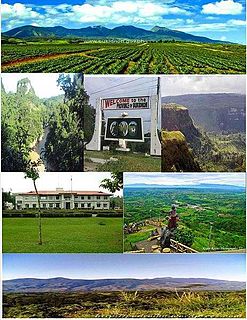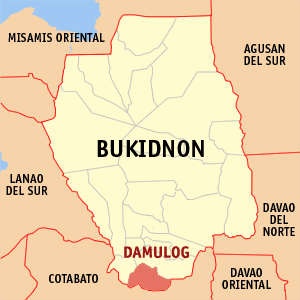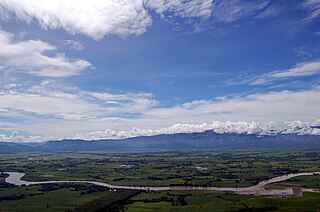
Bukidnon is a landlocked province in the Philippines located in the Northern Mindanao region. Its capital is the city of Malaybalay. The province borders, clockwise from the north, Misamis Oriental, Agusan del Sur, Davao del Norte, Cotabato, Lanao del Sur, and Lanao del Norte. According to the 2015 census, the province is inhabited by 1,415,226 residents. The province is composed of 2 component cities and 20 municipalities. It is the third largest province in the country in terms of total area of jurisdiction behind Palawan and Isabela respectively.

Malaybalay, officially the City of Malaybalay, is a 1st class city and capital of the province of Bukidnon, Philippines. According to the 2015 census, it has a population of 174,625 people.

Magpet, officially the Municipality of Magpet, is a 1st class municipality in the province of Cotabato, Philippines. According to the 2015 census, it has a population of 49,201.

Valencia, officially the City of Valencia, is a 2nd class city in the province of Bukidnon, Philippines. According to the 2015 census, it has a population of 192,993 people.

Cabanglasan, officially the Municipality of Cabanglasan, is a 3rd class municipality in the province of Bukidnon, Philippines. According to the 2015 census, it has a population of 33,997 people.

Damulog, officially the Municipality of Damulog, is a 4th class municipality in the province of Bukidnon, Philippines. According to the 2015 census, it has a population of 30,302 people.

Dangcagan, officially the Municipality of Dangcagan, is a 3rd class municipality in the province of Bukidnon, Philippines. According to the 2015 census, it has a population of 23,723 people.

Don Carlos, officially the Municipality of Don Carlos, is a 1st class municipality in the province of Bukidnon, Philippines. According to the 2015 census, it has a population of 66,959 people.

Impasugong, officially the Municipality of Impasugong, is a 1st class municipality in the province of Bukidnon, Philippines. According to the 2015 census, it has a population of 47,859 people.

Kadingilan, officially the Municipality of Kadingilan, is a 3rd class municipality in the province of Bukidnon, Philippines. According to the 2015 census, it has a population of 33,778 people.

Kibawe, officially the Municipality of Kibawe, is a 2nd class municipality in the province of Bukidnon, Philippines. According to the 2015 census, it has a population of 39,612 people.

Kalilangan, officially the Municipality of Kalilangan, is a 2nd class municipality in the province of Bukidnon, Philippines. According to the 2015 census, it has a population of 41,601 people.

Kitaotao, officially the Municipality of Kitaotao, is a 1st class municipality in the province of Bukidnon, Philippines. According to the 2015 census, it has a population of 50,260 people.

Malitbog, officially the Municipality of Malitbog, is a 2nd class municipality in the province of Bukidnon, Philippines. According to the 2015 census, it has a population of 24,453 people.

Manolo Fortich, officially the Municipality of Manolo Fortich, is a 1st class municipality in the province of Bukidnon, Philippines. According to the 2015 census, it has a population of 100,210 people.

Pangantucan, officially the Municipality of Pangantucan, is a 1st class municipality in the province of Bukidnon, Philippines. According to the 2015 census, it has a population of 53,126 people.

Quezon, officially the Municipality of Quezon, is a 1st class municipality in the province of Bukidnon, Philippines. According to the 2015 census, it has a population of 104,116 people.

San Fernando, officially the Municipality of San Fernando, is a 1st class municipality in the province of Bukidnon, Philippines. According to the 2015 census, it has a population of 56,138 people.

Musuan Peak or Mount Musuan, also known as Mount Calayo is an active volcano in Maramag, Bukidnon, on the island of Mindanao in the Philippines. It is 4.5 kilometres (2.8 mi) south of the city of Valencia, province of Bukidnon, and 81 kilometres (50 mi) southeast of Cagayan de Oro City.

The Pulangi River, also spelled Pulangui, is one of the major tributaries of the Rio Grande de Mindanao, an extensive river system in Mindanao, Philippines. With a length of 320 kilometres (199 mi), it is the longest river in Bukidnon and the 5th longest river in the Philippines. It traverses through majority of the cities and municipalities of Bukidnon from its source in Barangay Kalabugao, Impasugong, Bukidnon.































